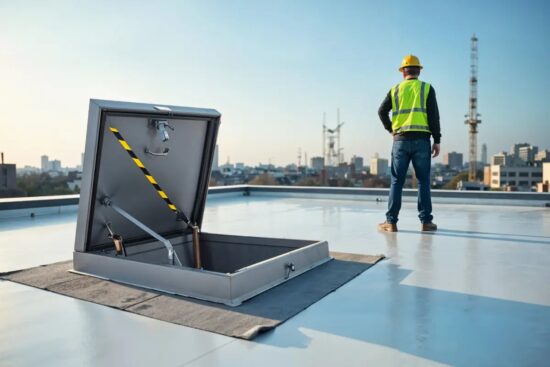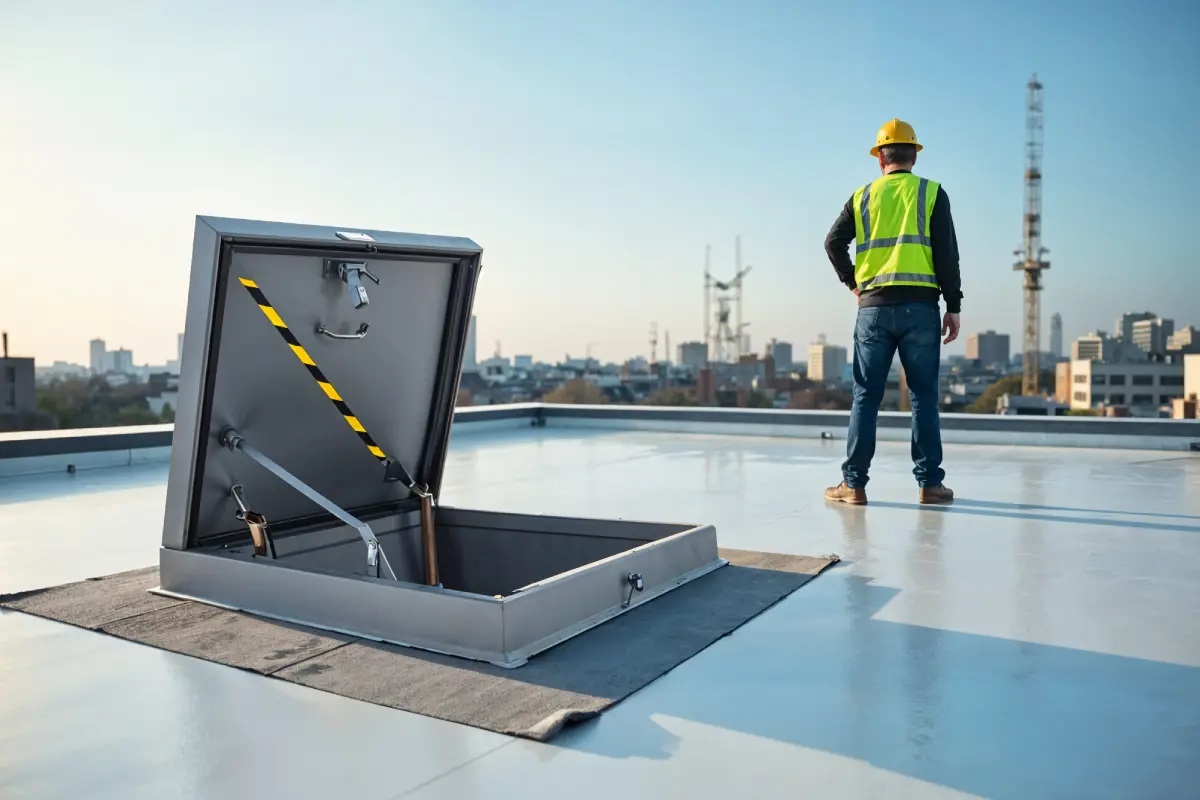
As a professional in the building industry, you know the importance of efficient and safe roof access. Proper access points can make routine tasks easier and more convenient.
Roof access doors provide a reliable and convenient solution. They help streamline operations and ensure the safety of your team.
In this post, we’ll discuss the specific benefits of roof access doors and how they can improve your maintenance practices.
What Are Roof Access Doors?
Roof access doors are entry points that provide safe and convenient access to building rooftops for maintenance, inspections, and other important tasks. They come in various sizes and styles, from small hatches to large doors, and are typically located on the exterior walls or roofline.
A roof access hatch, a specific type of access door often installed directly into the roof surface and open upward, offers an efficient solution for accessing rooftop areas. It’s essential for building maintenance, allowing for repairs, cleaning, and other activities requiring roof access.
Benefits of Roof Access Doors
As said, roof access door offers various advantages that significantly enhance building maintenance and safety. Here are some of their benefits:
- Improved Safety: Roof access doors are designed with safety features like secure locking mechanisms and compliance with building codes. This reduces the risk of accidents during maintenance activities.
- Easy Access for Inspections and Repairs: With designated access points, roofing contractors and safety inspectors can quickly reach the roof. This accessibility allows for efficient completion of regular inspections, maintenance tasks, and emergency repairs, ultimately improving building upkeep and reducing downtime.
- Enhanced Energy Efficiency: Properly installed roof access doors can help reduce energy by providing insulation and sealing against the elements, leading to lower heating and cooling costs.
- Cost-Effective Maintenance: Roof access doors can help identify issues early through routine inspections and maintenance tasks. They prevent costly repairs down the line and extend the roofing system’s lifespan.
Types of Roof Access Doors
Roof access doors come in various types, each designed to meet building requirements and safety needs. Some of these types include the following:
- Standard Roof Access Doors: These doors provide essential access for routine maintenance and inspections. They are typically easy to install and suitable for various building types, ensuring reliable rooftop entry.
- Insulated Roof Access Doors: Designed to improve energy efficiency, these doors help maintain building temperature control. They are ideal for climates where heat loss or gain can significantly impact energy costs.
- Heavy-Duty Roof Access Doors: Built to withstand high traffic, these doors are suitable for commercial or industrial settings. Their strong construction supports regular use without compromising safety or functionality.
- Fire-Rated Roof Access Doors: These doors help meet strict building regulations and delay the spread of fire for a time. Fire-rated access doors are essential in commercial buildings where high standards must be upheld.
- Skylight Roof Access Doors: Combining functionality with natural light, skylight hatches allow for easy rooftop access while illuminating interior spaces. These are ideal for buildings needing both access and daylight.
Factors to Consider When Choosing Roof Access Doors
Choosing the right roof access door ensures safety, efficiency, and compliance in any roofing project. Here are five important factors to consider:
- Material: Choose durable materials that withstand weather conditions and meet the specific needs of a building.
- Insulation: Opt for insulated doors to enhance energy efficiency and maintain climate control within the property.
- Size and Configuration: Ensure the door size and opening mechanism suit the roof’s design and provide easy access for personnel and equipment.
- Safety Features: Look for doors with safety features such as non-slip surfaces, proper locking mechanisms, and compliance with safety regulations.
- Cost and Warranty: Consider the budget for installation and ongoing maintenance of components. Additionally, check the warranty to ensure long-term performance and support.
What Roofing Contractors Need to Know
Here are some important things that roofing contractors must know:
1. Building Codes
Roofing contractors need to understand local building codes to ensure compliance during installations. These regulations are made to protect the safety and welfare of occupants, making it essential for contractors to stay updated on any changes.
Familiarity with these codes can prevent costly mistakes and legal issues. Knowing the requirements helps contractors design and implement roofing systems that meet all necessary standards.
2. Material Options
Different materials, like asphalt shingles, metal, and tiles, have unique benefits and drawbacks that impact performance and longevity.
For example, contractors should consider durability, cost, and aesthetics when recommending materials to clients when choosing access doors and panels. This allows them to provide tailored solutions that best fit each project’s needs.
3. Installation Techniques
Mastering various installation techniques is important for roofing contractors. Proper methods ensure that roofs are installed correctly, minimizing the chances of leaks and structural issues.
4. Maintenance Requirements
Educating clients on proper roof maintenance is an important responsibility for contractors. Routine inspections and maintenance can prevent small issues from becoming major problems, saving money.
Conclusion
Roof access doors are an asset for any building. They provide a safe, convenient, and efficient way to access the roof, allowing efficient inspections, repairs, and maintenance tasks.
Investing in quality roof access doors leads to better building upkeep and improved longevity of the roofing system.

